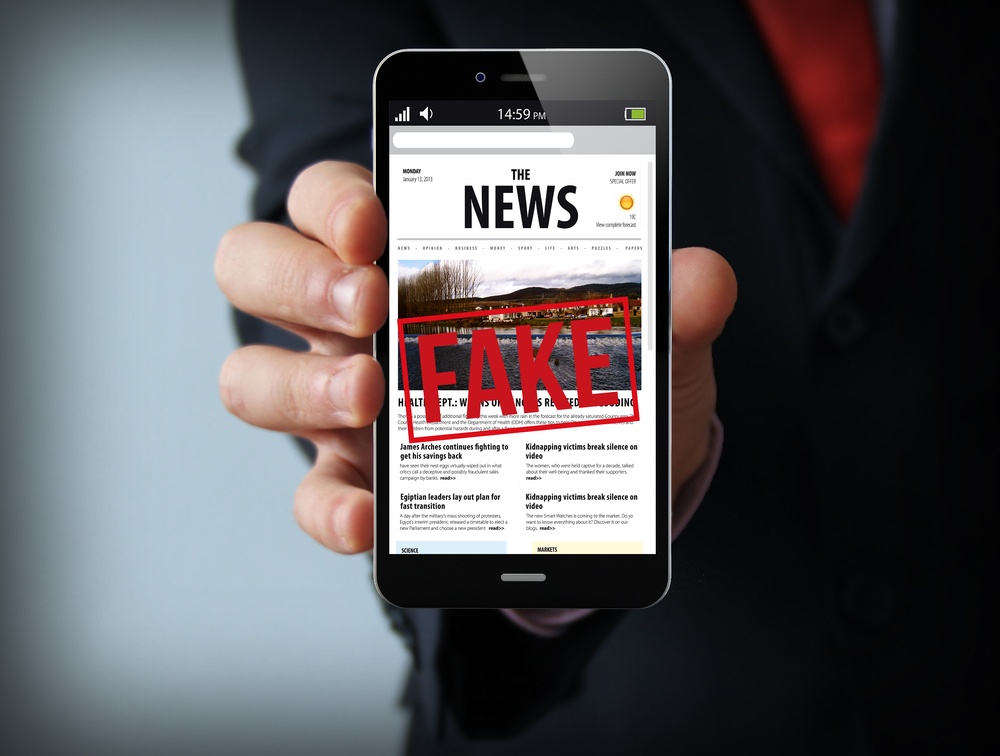
False information has always been in the media outlook. In 1938, the theater company Mercury, directed by the actor Orson Welles, presented an adaptation to a radio soap opera of The War of the Worlds, originally by H.G. Wells, published in 1895.
The performance and sound effects were so real that the audience was persuaded, at least for a moment, that it was a Martians invasion. Welles and his team achieved their goal: to make their audience believe a false situation. Although his main intention was not to create panic, this situation became a "fake news" because the purpose wasn't clear, meaning that nothing indicated it was something fictitious.
The next day, the headlines of North American press showed the panic and the hysteria that it provoked among the inhabitants of the area. During the following months, some psychologists teams investigated the irrational behaviors that caused a false situation. That was the first "media hoax".

Today, the Internet has allowed unlimited access to information and gave millions of people a platform to communicate and say whatever they want. The situation worsened with the media arrival, which multiplied so much the reach of these "creators", that little by little, media has been losing control of information. Additionally, facing internet, media has turned to it to try to inform with the same speed, causing the abandonment of the old reporting methods and data verification. We are facing a vicious circle.
Welcome to the "fake news" and post-truth era.
The term "fake news" is related to the past US elections, in which internet pages flooded social media with notes discrediting Hillary Clinton and/or speaking well of Donald Trump. Subsequently, the US president has used it to disqualify all media that do not communicate the official version of the White House and/or are critical of the government.
In 2016, the word of the year for the Oxford dictionary was "post-truth". For the publication, post-truth occurs when "objective facts have less influence in defining public opinion than those that appeal to emotion and personal beliefs".
There are many post-truth and "fake news" examples, what is relevant today is that people believe and spread them without hesitation, which creates a vicious circle in which even the most prestigious media have fall over and that social media have used like never before in the history of mankind. The reason why "fake news" is so powerful is their speed and their low production cost.
Do "fake news" really affect brands?
From my experience, I could not assure that "fake news" directly affect brands, no even in a public relations context in which the reputation is won based on who give a positive feedback about you.
However, for a publicist, it is imperative to identify sources and confirm them before showing results. "Fake news" commonly are in the digital domain and it is extremely complicated that a crisis starts from there, precisely because unreliable information can be.
Beware about it: we are in the elections year. In a period like this, the conversation is different: according to the anthropologist Roger Batra, post-truth is a phenomenon based on spreading lies on the internet via social media in order to modify perceptions of reality. It is a pathology for which there is no immediate cure. It happened 6 years ago when pollsters assured that Enrique Peña Nieto was the winner because of an overwhelming difference and in the end the end margins were much lower.
The "fake news" danger is real.
However, although it is possible that "fake news" doesn't directly affect well-established brands with a good image, they can cause "collateral" damage, which manifests itself when a brand is advertised on a site as "fake news" so that negative charge would be transferred to the brand.
A YouGov poll posted last August by WARC showed that 54% of participants would think negatively of a brand whose advertising was in a deceptive site, while two-thirds of them said they would trust in that brand.
But if it is the same brand that is spreading false content, most of the respondents would stop buying it (54%), choose a different brand in the future (51%) or tell their family and/or friends about it (51%).
There are other ways in which "fake news" can affect your company, for example:
- A communication error, for example, when you spread false news without any intention of it through your channels (be careful with your corporate social networks).
- Advertising has poorly done, for example, when the consumer doubts the values or honesty of your brand due to a communication from you.
- A managing error, for example, when you make a bad internal decision based on a "false news."
Speaking of consumers, Toluna, digital insights worldwide provider, conducted a study that revealed 41% of respondents are concerned about "fake news", especially young people between 18 and 29 years, followed people between 30 and 55 years and finally, people 55 and older.
What to do if a "fake news" about your brand emerges and begins to go viral?
In the networks, there is always a lie, criticism, rumor or transcendence that has ever attacked a brand. Monitoring mechanisms and a methodology with preventive steps and analysis to avoid falling into crisis after any "negative note" that comes out on the networks are needed. This methodology should help customers know that not everything that happens, and less in the digital universe, is equal to crisis.
There are very outstanding "fake news", especially when they have immediate or short-term effects (like the War of the Worlds case), but there are others that are gradually building up and blurring, like the rumors of not going out to vote because the army in the streets or those who talk about an event or show, "advising" people not to go because there are no tickets.
As much as possible, you always have to get the original source to be able to really know where the information comes from and to be able to use it. Nowadays, it is not enough to trust that it is a "serious" media or journalist, because the truth is that everyone is susceptible might use false information and spreading it as true. It is important for publicists to never rely just on the media or on whoever says it, but on reaching the original source.
6 tips to avoid that "fake news" affect you
Now let's see how to prevent a "fake news" crisis:
- Follow up your brand and industry's reputation, both in the web and in social networks (remember that when a rumor about a brand merged, people tend to go to the networks to know if this is true, and they don't mind confirming the information because it is easier to talk about it, take it for granted, and disseminating it, creating a terrible vicious circle.)
- Previously identify subjects that may arouse an audience reaction.
- Speak with the emotional language that your consumers use and prefer, especially in social networks.
- Be authentic and build a relationship with your audience.
- Double-check the information you receive and share on networks.
- Be aware of the nature and reputation of the places where you advertise. To avoid publicizing yourself in deceptive sites, it is important to approach an expert agency that helps you to be where you really want to be.
Is there a way to end with the "fake news"?
It is a fact that the media have a great responsibility to end the "fake news". They need to be much more professional to inspire confidence and seriousness, which will cause them to win back the audience with objectivity, without leaving technology aside, but on the contrary, using it in their favor. This will eventually cause the audience to be willing to pay for good content.
Brands must be responsible for the information they spread in their messages, but also in the information they use to make decisions. Come to us so we can help you formulate the best strategy to achieve this goal.

